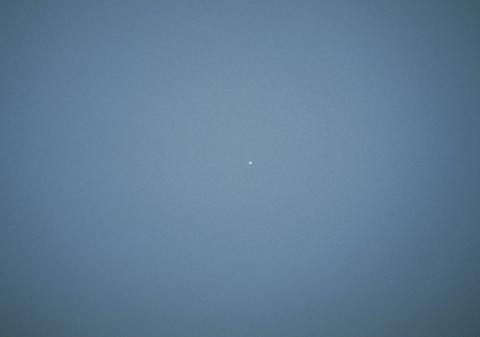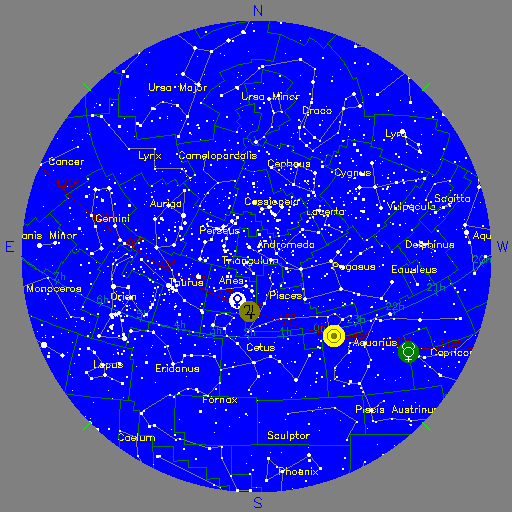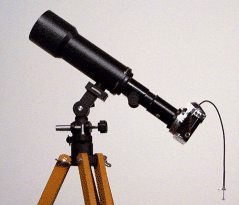
|
Viewing Venus in Broad Daylight by John Walker |

|

| Venus in the mid-afternoon sky, photographed from Muir Beach, California in the United States on March 13th, 1988. |

|
Viewing Venus in Broad Daylight by John Walker |

|

| Venus in the mid-afternoon sky, photographed from Muir Beach, California in the United States on March 13th, 1988. |
For almost twenty years I lived near the Pacific coast of California, north of San Francisco (in Marin County). While the climate is superb (if you don't like hot weather, which I detest) and the scenery is magnificent, for an amateur astronomer like myself, there's one huge drawback: the fog. Mark Twain once remarked that the coldest winter he recalled was a summer in San Francisco. Although it rarely rains in the summer, almost every evening dense fog rolls in from the Pacific, reducing visibility to next to nil. On many days which dawn enveloped in fog, the Sun does manage to burn it off in the middle of the day, but come the evening the fog rolls right back in, much appreciated, no doubt, by the huge slimy slugs which outnumber primates in the region, but distinctly less so among said primates who amuse themselves by peering through telescopes.
I mean, astronomers are stargazers, and if the only time the sky isn't shrouded in fog is mid-afternoon, that kind of pares down the list of things at which one might direct one's gaze. Daytime optical astronomy seems a subject uniquely devoid of objects: the Sun, Moon, Venus, the occasional comet, the exceptional bolide, and the odd supernova pretty much exhaust the list of potential targets.
Venus? Yes. When Venus is bright and far from the Sun in a clear sky, you can observe this planet in broad daylight with the unaided eye. Here's how.
I've found that the best way to spot Venus in the daytime is to first note the angular distance between the Sun and Venus by observing Venus shortly after sunset. Then, the next day, find an observing site where the Sun is blocked from view (essential both for eye safety and to allow the iris to dilate and see Venus better against the sky). From that location, sweep the sky in overlapping fields with binoculars pre-focused at infinity by observing an object on the horizon. Sweep along the ecliptic in the area with the angular separation from the Sun noted the previous night. Since the Sun is blocked from view at your observing site, you can freely scan the sky without fear of damaging your vision by inadvertently sweeping past the Sun.
 When you sweep past Venus, you'll know it. Even with my battered,
poorly collimated, and cheap 6×30s, Venus is a brilliant speck of
white against the blue sky. Once you've found Venus with binoculars,
put the binoculars down and observe that area of sky with the naked
eye. If the sky is perfectly clear your eye has no reference to focus
upon so if you've learned the trick of consciously focusing your eyes,
changing the focus may help Venus pop out from the sky.
When you sweep past Venus, you'll know it. Even with my battered,
poorly collimated, and cheap 6×30s, Venus is a brilliant speck of
white against the blue sky. Once you've found Venus with binoculars,
put the binoculars down and observe that area of sky with the naked
eye. If the sky is perfectly clear your eye has no reference to focus
upon so if you've learned the trick of consciously focusing your eyes,
changing the focus may help Venus pop out from the sky.
Another trick I use to spot Venus in the daytime sky with the naked eye is to focus on the horizon, then quickly look up to the area of sky where Venus shines—the eye tends to remain focused at infinity, and Venus is found more readily. Looking up from a head-level position also seems to minimise interference from material floating within the eye. If the Moon is visible in the daytime sky, I've found that observing it to focus the eye, then sweeping over to Venus also works well.
The more transparent the sky, the more visible Venus will be; I've spotted Venus on afternoons with a very light haze, but anything more than that makes naked-eye observation extremely difficult, if not impossible. You can estimate the transparency of the sky by observing how close to the Sun the sky remains blue—the smaller the white dazzle around the Sun, the clearer the sky. Don't, of course, stare directly at the Sun unless you want to permanently conclude your astronomical career.
I find the sight of Venus shining forth from a brilliant blue mid-afternoon sky not only inherently beautiful (when else can you see a pinpoint of light piercing the daytime sky?), but rewarding to the observer in the sense that you're seeing a sight that billions of people could see if they bothered to look, but which only a very few people will ever observe in their lifetimes.
 It's also possible to photograph Venus in broad daylight. The photo
at the top was taken at 14:30 Pacific Standard Time on March 13th, 1988,
with Ektachrome 200 film through an 80mm Brandon apochromatic
refractor with the image projected onto the film plane of a Nikkormat
camera by a Brandon 20mm focal length wide-angle eyepiece. The
shutter speed was 1/250 second. The slide from which the above image
was scanned was taken from Muir Beach, California (37°52'N 122°35'W).
It's also possible to photograph Venus in broad daylight. The photo
at the top was taken at 14:30 Pacific Standard Time on March 13th, 1988,
with Ektachrome 200 film through an 80mm Brandon apochromatic
refractor with the image projected onto the film plane of a Nikkormat
camera by a Brandon 20mm focal length wide-angle eyepiece. The
shutter speed was 1/250 second. The slide from which the above image
was scanned was taken from Muir Beach, California (37°52'N 122°35'W).
So far, I've failed to capture Venus through a normal lens when the Sun was unobscured in the sky, though I've taken several slides which, if summed, might possibly reveal Venus. The problem is that the image of Venus through a normal lens is on the order of the grain size of Ektachrome film, so it's hard to dig the image of Venus out of the random grain pattern of the resulting slides. Using finer grain films such as Kodachrome 25 and red filters which enhance the contrast of white Venus against the blue sky may help. If you succeed in photographing Venus in the daytime with a normal lens, let me know; I'll be happy to publish your pictures here with full attribution and/or link to your page containing the photos.
Once you've found Venus in the daytime sky, it's a rewarding telescopic object at high magnifications. Waning gibbous Venus against a brilliant blue sky is a sight few people have seen. The bright background actually makes the phase easier to see than at night when the glare of Venus against a black sky often makes one reach for a neutral density filter.
When the photograph at the top of this page was originally taken, CCD
cameras were just becoming available to bleeding edge of amateur
astronomers willing to homebrew custom and expensive hardware with
many compromises. The extent to which CCD cameras have revolutionised
astronomy, professional and amateur, in the succeeding years is
extraordinary; comparable to the transition from visual observation to
the photographic plate. CCDs have changed all the rules. In
particular, the very large dynamic range of CCDs and the ability to
subtract dark field and sky background permits one to routinely
capture third and fourth magnitude stars in broad daylight, assuming
the sky is clear. (I've never done this myself, but I've read
numerous uncontested reports of success.) I sense a challenge here:
how deep can you go, when the Sun (centre of disc) is at
least 30 degrees above the horizon? Send me your daytime starshine
CCD images and I'll link them to your page or, if you prefer, I'll
link directly to your own page containing the images.
The best time to view Venus in the daytime is when it's near greatest elongation—at the greatest angular distance from the Sun as seen from Earth. If your browser supports JavaScript (and is configured to permit JavaScript programs to run), the following calculator will show you the dates of maximum elongations of Venus for any given year. Due to the geometry of the orbits of Venus and the Earth, the number of maximum elongations in a given year varies between zero (no maximum elongation at all) and two. The magnitude of Venus around maximum elongation is always about −4.1; at maximum brightness Venus is about magnitude −4.4, but maximum brightness occurs when Venus is closer in the sky to the Sun.
|
Click on titles to order books on-line from
|
All images in this document are in the public domain and may be used in any manner without permission, restriction, attribution, or compensation. Back links to Viewing Venus in Broad Daylight are welcome.